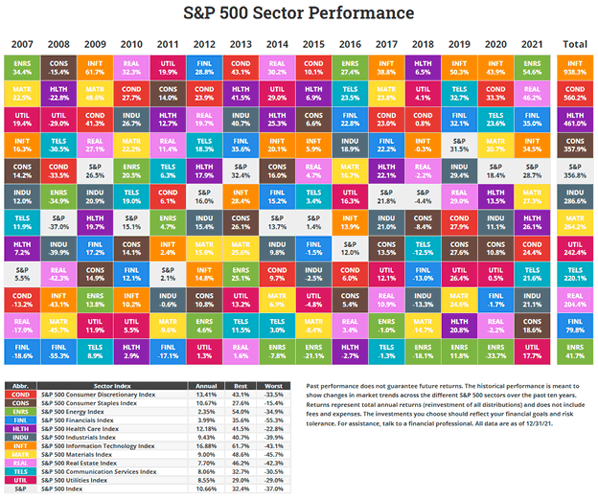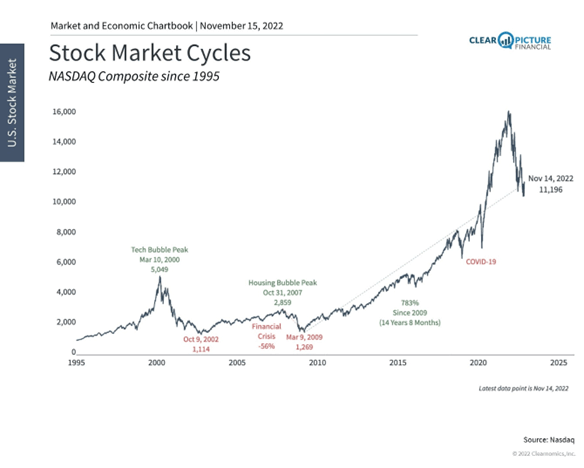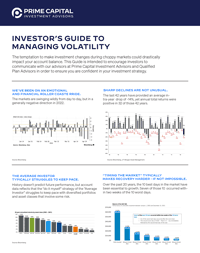The tech world witnessed some woes in 2022. How does it affect your portfolio and asset allocation?
Technology has transformed our world and our daily lives. Computers are getting increasingly faster, and the days of the modem sound, click here if you miss it, are long gone (thank goodness!). However, we are seeing a lot of bad news and market disruption in the information technology sector this year. Thusly, that will be the focus of this month’s newsletter. Due to its size and historical performance, tech is an important sector of the global economy, and it is especially important to the U.S. stock market and economy. This sector represents 26% of the S&P 500, and in the last 15 years, it has been the best sector in 4 of those years, as shown in the chart below.
Over the past decade, the tech sector has benefited as the digital revolution has accelerated, including during the pandemic when technology enabled work-from-home, home fitness, entertainment, and other capabilities. However, slowing consumer and business demand, return-to-office trends, rising interest rates, company-specific events, and the crash in cryptocurrencies have put a damper on the sector. Despite recent gains, the Nasdaq declined 28% this year, worse than the 16% and 7% losses for the S&P 500 and the Dow, respectively.
All investors understand that markets operate in cycles. Market cycles are even more prominent in technology stocks, which depend on the underlying business cycle and experience waves of hype and exuberance. Benjamin Graham, often considered the father of value investing, famously stated that, “In the short run, the market is a voting machine, but in the long run, it is a weighing machine.” While fundamentals like earnings and P/E ratios matter over years and decades, stock prices can more closely resemble a popularity contest over days, weeks, and months. It is often too hard to distinguish between the two means, so for long-term investors, it’s essential to maintain balance when markets swing too far in either direction.
There are three key points to understand the illustrated point through the performance of the Nasdaq.
- These numbers need to have context.
Despite the volatility and poor year-to-date performance, the Nasdaq has held onto gains of 15% since the Feb. 2020 pre-pandemic peak and 65% since the pandemic lows. The S&P 500 tech sector has more than doubled over the past few years. Of course, the wild ride over this period, as shown in the chart below, makes it feel worse than these numbers might suggest.
- It’s important to distinguish between economy-wide factors and company-specific ones.
Rising rates, for instance, disproportionately impact tech stock valuations because their cash flows are potentially far off into the future. When interest rates increase, the present value of these cash flows declines at a faster pace. Not only does this affect price levels, but uncertainty around rates can cause large swings in both directions. A recent example includes a one-day jump of 7.4% for the Nasdaq in reaction to positive inflation data. These factors have kept the price-to-earnings ratios for tech-related sectors around 20x, well above the S&P 500’s multiple of 16.5x.
Unfortunately, these headwinds have also resulted in sizable layoffs across tech companies. One estimate, from Layoffs.fyi, suggests that there have been 51,300 individuals laid off across 204 tech companies so far just in the month of November. While this has not translated into broader layoffs across the economy, the sheer magnitude is significant compared to the net gain of 4,000 information jobs and the 261,000 total payrolls added in October.
- There is a significant difference between now and the early 2000s.
Many tech companies are not only profitable now but have long-established business models. This current market a stark contrast to the dot-com crash in 2000 when some highly valued internet companies were backed by little more than promises. Today’s tech companies span beyond information technology and into many sectors such as energy and health care.
Unfortunately, profitability and adoption are still open-ended questions for the most hyped parts of the tech sector. Blockchain and cryptocurrencies, for example, have struggled due to falling coin prices and, more recently, the collapse of FTX. In case you are wondering, unless we had lengthy conversations, you do not have digital assets in your portfolio!
Regardless of one’s views on digital currencies, it’s essential to maintain diligence and construct portfolios properly to minimize risk while benefiting from trends.
Thus, the current market environment highlights the aftermath of valuations becoming detached from reality. In all markets, the question of whether and how much to invest in any asset class, a blue-chip stock, hyped tech stock, or a Treasury bond, depends on the risk and return characteristics relative to a balanced portfolio. While shake-ups are occurring in the tech space, the need for diversification and proper portfolio allocation, ideally with the guidance of a trusted advisor, has stayed the same.
The bottom line? With challenges among tech companies and in the crypto space in the headlines, investors ought to stay focused on the long run and maintain proper portfolio allocations across sectors. If you’d like to discuss the current landscape of tech sectors and how it impacts your portfolio, please schedule an appointment with me!








